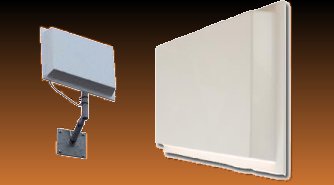CPE Wifi Client Integrated Radio and Antenna Index
Contents
[hide]Motorola Canopy Wireless
Canopy Access Point (AP)
The Access Point (AP) is a base station that can incorporate between one and twelve transceivers. Each transceiver operates with a 60-degree directional antenna to provide coverage to one sector. Each AP transceiver delivers up to 6.5 Mbps of data through put with connectivity to 200 subscribers. Systems with more than three access point transceivers should use an AP Installation Kit which includes an Ethernet switch, AC power supply, Global Positioning System (GPS) receiver with interconnect board; this receiver is used to synchronize the transmissions of all APs to minimize interference between APs. The AP operates with a Radio Frequency (RF) bit rate of 10 Mbps and has a range of approximately two or ten miles, depending on configuration. Each AP transceiver requires a 24-volt power source (included in AP installation kit) and provides a single 10BaseT/100BaseTX connection.
Canopy Subscriber Module (SM)
The Subscriber Module (SM) is the subscriber termination unit. It consists of a single transceiver that operates with a 60-degree antenna. An optional reflector assembly which will extend the range to 10 miles is available (only on 5.7 GHz models in FCC countries). SM synchronization and control is accomplished via the received AP signal. SMs may be located either in – or outdoors, depending on the distance from the AP. Once the SM is initialized, it scans the RF channels and automatically registers and authenticates with the appropriate AP. Each SM requires a Category 5 cable with DC power supplied to the SM through that same cable. The SM kit requires a separate 110 or 220V power supply (ACPS110 or ACPS220) and associated RJ45 connector to power the SM.
Canopy Backhaul Unit (BU)
The Backhaul Unit (BU) is a point-to-point radio that is used to carry traffic to and from APs. In the event that no convenient fiber or cable connects are available for an AP, a BU will be required. Each BU communicates to a single BU utilizing a highly directional antenna. In each backhaul link one device is configured as the RF timing master (5700BHMRF). The BU timing master generates the timing information sent to that the timing slave (5700BHSRF). The BU operates with an RF bit rate of 10 Mbps with a throughput of 7.5 Mbps and has a maximum range of approximately 20 miles. The BU uplink/downlink bandwidth ratio for a single BU link is configurable by the operator (i.e. 5Mbps downlink and 2.5Mbps uplink or 3.75 Mbps bi-directional.). When two BU pairs are configured back to back they both need to be configured for symmetrical load with 3.75 Mbps in each direction. Each BU requires a separate 110 or 220V power supply (ACPS110 or ACPS220) and associated RJ45 connector to power the BU. The BU can also be connected to the AP Installation Kit, which will supply power to the BUs and interconnection to the APs.
Tranzeo Wireless Technologies CPE
Tranzeo TR-CPE90-15
2.4GHz 802.11b/g CPE and AP unit with integrated 15dBi panel antenna. Includes multi MAC bridge support, Web management, WPA.
Tranzeo TR-5a-20f
The TR-5A series is Tranzeo's 5.8 GHz product. These are integrated fully functioning radios, which means these units can be configured as an Access Point, a Point to Point Bridge, or a Client Adapter (CPE).
EnGenius Technologies, Inc.
EOC1650
EnGenius EOC1650 Outdoor Wireless AP/Bridge is a low cost, indoor / outdoor, 802.11g Outdoor 200mW Bridge / Access Point with Dual Antennas. Equipped with an internal directional antenna and connection for an external antenna, includes an omnidirectional external antenna. Power over Ethernet. Multiple operation modes are Access Point / Client Bridge / Client Router with speed up to 54Mbps. Includes POE power injector for outdoor deployment.

